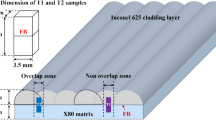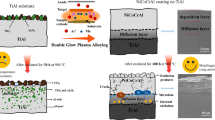Conclusions
-
1.
It is shown that the angles of contact formed on silicon carbide at Si-Ti and Si-Cr alloys containing up to 10 wt.% of titanium and chromium at their temperatures of transition to a liquid state (1415–1380°C) and at 1500 and 1600°C are similar to those formed by pure silicon (contact time 1.5–3 min).
-
2.
It has been established that, at 1415°C, titanium is more potent as an interfacially active addition than chromium.
Similar content being viewed by others
Literature cited
Yu. V. Naidich and G. A. Kolesnichenko, Reactions of Metallic Melts with Diamond and Graphite Surfaces [in Russian], Naukova Dumka, Kiev (1967).
M. Hansen, Constitution of Binary Alloys, McGraw-Hill (1958).
V. P. Elyutin, V. I. Kostikov, and V. Ya. Levin, Izv. Vysshikh Uchebn. Zavedenii, Tsvetn. Met., No. 1, 53 (1970).
B. A. Baum and P. V. Gel'd, Zh. Fiz. Khim.,40, No. 7, 1462 (1966).
V. L. Yupko and G. G. Gnesin, Poroshkovaya Met., No. 10 (1973).
Author information
Authors and Affiliations
Additional information
Translated from Poroshkovaya Metallurgiya, No. 1 (133), pp. 77–79, January, 1974.
Rights and permissions
About this article
Cite this article
Yupko, V.L., Gnesin, G.G. Wetting of silicon carbide by binary Si-Ti and Si-Cr alloys. Powder Metall Met Ceram 13, 59–61 (1974). https://doi.org/10.1007/BF00790688
Received:
Issue Date:
DOI: https://doi.org/10.1007/BF00790688




